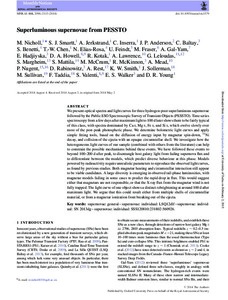Superluminous supernovae from PESSTO
Nicholl M; Smartt SJ; Jerkstrand A; Inserra C; Anderson JP; Baltay C; Benetti S; Chen TW; Elias-Rosa N; Feindt U; Fraser M; Gal-Yam A; Hadjiyska E; Howell DA; Kotak R; Lawrence A; Leloudas G; Margheim S; Mattila S; McCrum M; McKinnon R; Mead A; Nugent P; Rabinowitz D; Rest A; Smith KW; Sollerman J; Sullivan M; Taddia F; Valenti S; Walker ES; Young DR
https://urn.fi/URN:NBN:fi-fe2021042715220
Tiivistelmä
We present optical spectra and light curves for three hydrogen-poor superluminous supernovae followed by the Public ESO Spectroscopic Survey of Transient Objects (PESSTO). Time series spectroscopy from a fewdays aftermaximum light to 100 d later shows them to be fairly typical of this class, with spectra dominated by Ca II, MgII, FeII, and Si II, which evolve slowly over most of the post-peak photospheric phase. We determine bolometric light curves and apply simple fitting tools, based on the diffusion of energy input by magnetar spin-down, Ni-56 decay, and collision of the ejecta with an opaque circumstellar shell. We investigate how the heterogeneous light curves of our sample (combined with others from the literature) can help to constrain the possible mechanisms behind these events. We have followed these events to beyond 100-200 d after peak, to disentangle host galaxy light from fading supernova flux and to differentiate between the models, which predict diverse behaviour at this phase. Models powered by radioactivity require unrealistic parameters to reproduce the observed light curves, as found by previous studies. Both magnetar heating and circumstellar interaction still appear to be viable candidates. A large diversity is emerging in observed tail-phase luminosities, with magnetar models failing in some cases to predict the rapid drop in flux. This would suggest either that magnetars are not responsible, or that the X-ray flux from the magnetar wind is not fully trapped. The light curve of one object shows a distinct rebrightening at around 100 d after maximum light. We argue that this could result either from multiple shells of circumstellar material, or from a magnetar ionization front breaking out of the ejecta.
Kokoelmat
- Rinnakkaistallenteet [27094]
